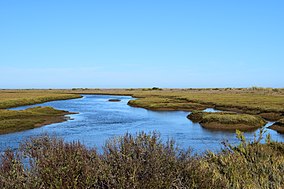| Ria Formosa Natural Park | |
|---|---|
IUCN category V (protected landscape/seascape) | |
 | |
| Location | Algarve, Portugal |
| Coordinates | 36°59′51.5″N 7°51′39.2″W / 36.997639°N 7.860889°W |
| Area | 179.01 km2 (69.12 sq mi)[1] |
| Established | May 2, 1978 |
| Governing body | ICNF |
| Designated | 24 November 1980 |
| Reference no. | 212[2] |
The Ria Formosa lagoon, located in the Algarve, in southern Portugal, is a system of barrier islands that connects to the sea through six inlets. Five of these inlets are natural and have mobility characteristics. The sixth is an artificial inlet that was opened with the purpose of allowing easier access to the port of Faro. In 2010, the lagoon was recognised as one of the country’s seven natural wonders.[3] Following a public vote in which 656,356 voted, the Ria Formosa was announced the winner of the Marine Area category of the ‘7 Maravilhas Naturais de Portugal’.[4]
Presently the main inlet of the system is the Faro-Olhão inlet, which is an artificial construction. The process started in 1927 but it was only in 1952 that the engineering works were completed and it assumed the present configuration.


Part of the system is a 170 km² protected natural area, but Ria Formosa also plays an important role in the region's economy. Beyond the tourist use the system also supports other economic activities like seafood farms (including grooved carpet shell harvesting) and the port of Faro. Besides being a natural park, Ria Formosa is classified as a Ramsar site.[5] It is also listed by BirdLife International as an Important Bird Area, both in its lagoon area with 23,296 hectares[6] and the oceanic zone with 19,900 hectares.[7] It serves as a stopping place for migratory birds during the spring and autumn migratory periods.
The most important cities near the Ria Formosa are Tavira, Faro and Olhão.
- ^ "Ria Formosa | DOPA Explorer". dopa-explorer.jrc.ec.europa.eu. Retrieved 31 May 2021.
- ^ "Ria Formosa". Ramsar Sites Information Service. Retrieved 25 April 2018.
- ^ The Ria Formosa wetravelportugal.com. Retrieved 15 August 2021.
- ^ Maravilhas Naturais de Portugal 7maravilhas.pt. Retrieved 15 August 2021.
- ^ Ramsar Sites Information Service (1992). "Ria Formosa". Retrieved September 26, 2016.
- ^ BirdLife International. "BirdLife Data Zone: Ria Formosa (Faro lagoon)". Retrieved May 5, 2020.
- ^ BirdLife International. "BirdLife Data Zone: Ria Formosa - Oceânica". Retrieved May 5, 2020.
